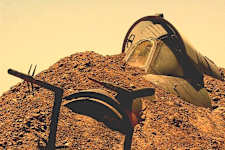Many cities may even experience the coldest Christmas in decades -- and in some cases, ever. But a major weather pattern turnabout will have temperatures climbing in time for the new year across much of the nation.
By Alex Sosnowski, AccuWeather senior meteorologist
Published Dec 23, 2022 11:24 AM EST | Updated Dec 23, 2022 2:10 PM EST
Bitter cold is plunging much of the eastern two-thirds of the nation into a deep freeze and allowing for some eye-popping record-low temperatures to be shattered across parts of the United States. Many cities may even experience the coldest Christmas in decades -- and, in some cases, ever. Bottom line: It's downright cold. But AccuWeather meteorologists say there's good news around the corner. The weather pattern is about to be flipped on its head, and a warmup is in store for the final days of 2022. However, some places will feel relief from the cold much faster than other locations.
"A major shift in the jet stream will occur next week," AccuWeather Lead Long-Range Meteorologist Paul Pastelok said. "Instead of a massive dip in the jet stream that allows air from the North Pole to empty into the U.S., a more west-to-east jet pattern will develop and allow milder air from the Pacific to flow across much of the nation."

The strong warming trend is likely to be good news for millions of people heading home from holiday destinations or to getaways for the new year. Higher temperatures should also help ease the strain on energy demands and on wallets due to high heating costs during the Arctic outbreak.
Portions of the Rockies, Great Plains and Mississippi Valley will experience the most striking and fastest warmup.
"As the marine Pacific air flows downhill out of the Rockies and onto the Plains, temperatures will rise quickly and dramatically compared to the frigid conditions in the days prior to Christmas," Pastelok said.
For example, in Denver, where temperatures plummeted to 24 below zero F on Thursday morning, temperatures will rise into the 50s by Christmas Day and could hit 60 on Tuesday, forecasters say.
In Chicago, where a couple of days with highs in the single digits will be endured into the start of the Christmas weekend, temperatures are projected to climb into at least the 40s for multiple days during the second half of next week through the New Year's weekend.
The normal highs in Denver and Chicago are in the mid-40s and mid-30s, respectively.
Farther to the east, cold air may initially put up a little more of a fight, especially from the mid-Atlantic to the southeast corner of the nation.
An area of high pressure may hang on in the Northeast and even nose southward a bit during the middle and latter part of next week. "This allows cold air, which is denser than warm air, to remain wedged east of the Appalachians," Pastelok explained.
Despite the lingering cold air in the East, the New York City area will experience temperatures recovering into the 40s later next week, following one of the coldest Christmases since the 1980s. Temperatures could be in the upper 40s and lower 50s for New Year's Eve revelers at Times Square. The average high in midtown Manhattan on New Year's Eve is 41 F. Temperatures could even reach 60 by the first afternoon of 2023.

Farther south, in Charlotte, North Carolina, it may take until Thursday or Friday of next week before high temperatures recover to normal levels. A high of 52 is average for early January in the Queen City. Highs in the 60s should be common throughout the Carolinas and Georgia by New Year's weekend.
The same west-to-east jet stream pattern will allow storms from the Pacific to wander farther south as they move onshore along the West Coast and interior western U.S. This could bring multiple rounds of rain and mountain snow from California to New Mexico and Colorado.
Storms in recent months have delivered some needed moisture to the Southwestern states, and the pattern could bring additional drought-easing precipitation. Vast areas of severe to exceptional long-term drought continue over much of the Western states, according to the latest data from the United States Drought Monitor.
The same pattern could lead to potent storm systems that emerge from the Rockies and travel toward the Mississippi Valley during early January. Much of the Mississippi River basin could benefit from moisture, with the waterway's recovery sputtering after near-record-low water levels this past summer and autumn.

The pattern could continue to evolve to allow more rounds of severe weather over the South-Central and Southeastern states from late December to early January, AccuWeather Meteorologist Joe Bauer said.
"As a warm and moist air flow begins from the Gulf of Mexico and jet stream energy arrives from the Rockies, there may be one or more rounds of heavy, gusty to severe thunderstorms that develop near the Gulf coast to the southern Plains and or the lower Mississippi Valley later next week," Bauer said.
It is a bit early to pinpoint which precise areas from Texas to Arkansas, Tennessee and Florida might be hit with severe weather and when.
Another potential negative aspect of a warmup that follows an outbreak of Arctic air is the potential for widespread fog. Fog can form when warm, moist air flows over the top of snow cover or cold ground, given the right conditions.

AccuWeather will continue to provide updates on the scope and magnitude of the warmup as well as the severe weather and fog potential as the situation warrants next week. In the meantime, days of painful Arctic cold are in store for much of the nation for the Christmas weekend.
More to read:
Want next-level safety, ad-free? Unlock advanced, hyperlocal severe weather alerts when you subscribe to Premium+ on the AccuWeather app. AccuWeather Alerts™ are prompted by our expert meteorologists who monitor and analyze dangerous weather risks 24/7 to keep you and your family safer.







No comments:
Post a Comment